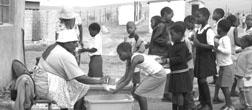Tuesday, September 13, 2005
HIV and Stigma
Stigma and disease has been intertwined throughout human history - cancer, leprosy, tuberculosis, mental illness, and the long list of STDs. Over the past two decades, HIV/AIDS has supplanted all other disease as the most feared and most stigmatized all over the world.
Other than the obvious physical symptoms, HIV/AIDS induces denial, fear, violence, silence, and isolation in many communities and individuals. These emotional reactions layer the stigma and thus undermine effective treatment from a public health scale. The stigma prevents condom use, HIV testing, and care-seeking. Therefore, reducing stigma through education is the foundation of solid ARV treatment.
Moreover, community-based programs need to lessen the following myths:
1. Fear of contracting HIV/AIDS through contact
2. HIV/AIDS is a death sentence
3. People with HIV/AIDS contracted through unacceptable behaviors, ie. promiscuity, IV drug use, homosexuality
The reason that many choose not to do HIV testing is that “not knowing is better than knowing”. This was particularly more evident when the South African government did not offer free ARV treatment, which meant knowing ones HIV status became a death sentence. Now instead, people wait until their bodies have nearly succumbed to AIDS. Why wait? Unfortunately, ARV treatment is only effective when the patient has fallen under a CD4 count of 200 which is parallel to full blown AIDS. Thus Nongoma patients prefer to delay knowing their status or in other words delaying the stigma until the body cannot withstand the virus any longer.
Unfortunately, Benedictine staff also faces the stigma of HIV/AIDS. At this point there are no mechanisms to provide confidentiality to staff. Many are afraid to get tested or receive treatment knowing that the entire hospital would soon find out their status. So even the educated succumb themselves to community discrimination with the willingness to die with dignity rather than with AIDS.
Other than the obvious physical symptoms, HIV/AIDS induces denial, fear, violence, silence, and isolation in many communities and individuals. These emotional reactions layer the stigma and thus undermine effective treatment from a public health scale. The stigma prevents condom use, HIV testing, and care-seeking. Therefore, reducing stigma through education is the foundation of solid ARV treatment.
Moreover, community-based programs need to lessen the following myths:
1. Fear of contracting HIV/AIDS through contact
2. HIV/AIDS is a death sentence
3. People with HIV/AIDS contracted through unacceptable behaviors, ie. promiscuity, IV drug use, homosexuality
The reason that many choose not to do HIV testing is that “not knowing is better than knowing”. This was particularly more evident when the South African government did not offer free ARV treatment, which meant knowing ones HIV status became a death sentence. Now instead, people wait until their bodies have nearly succumbed to AIDS. Why wait? Unfortunately, ARV treatment is only effective when the patient has fallen under a CD4 count of 200 which is parallel to full blown AIDS. Thus Nongoma patients prefer to delay knowing their status or in other words delaying the stigma until the body cannot withstand the virus any longer.
Unfortunately, Benedictine staff also faces the stigma of HIV/AIDS. At this point there are no mechanisms to provide confidentiality to staff. Many are afraid to get tested or receive treatment knowing that the entire hospital would soon find out their status. So even the educated succumb themselves to community discrimination with the willingness to die with dignity rather than with AIDS.
Subscribe to:
Post Comments (Atom)










No comments:
Post a Comment